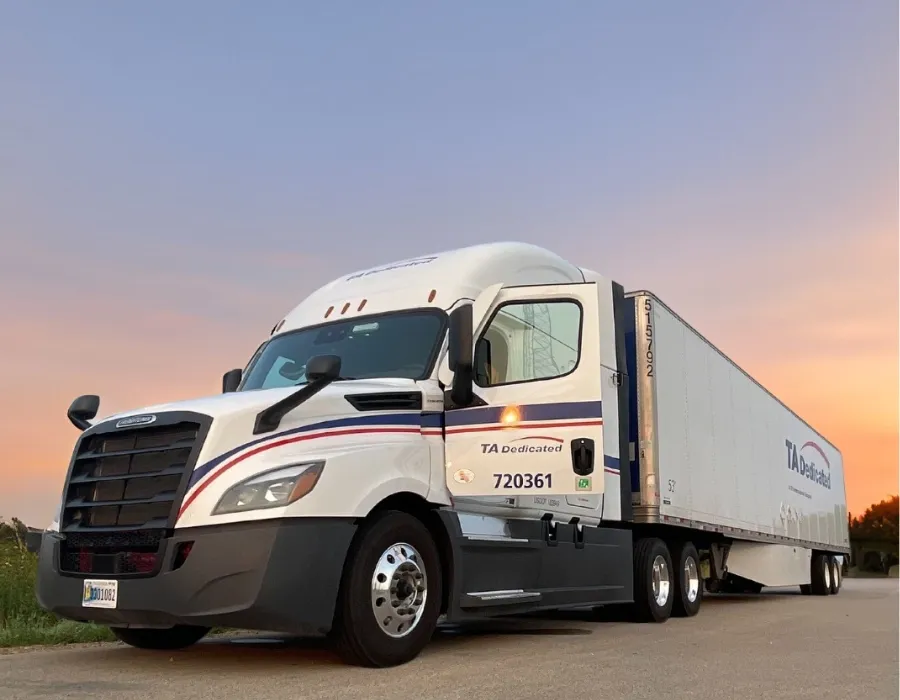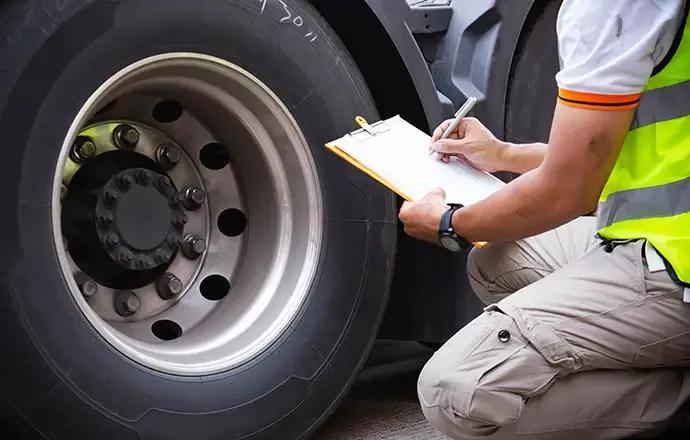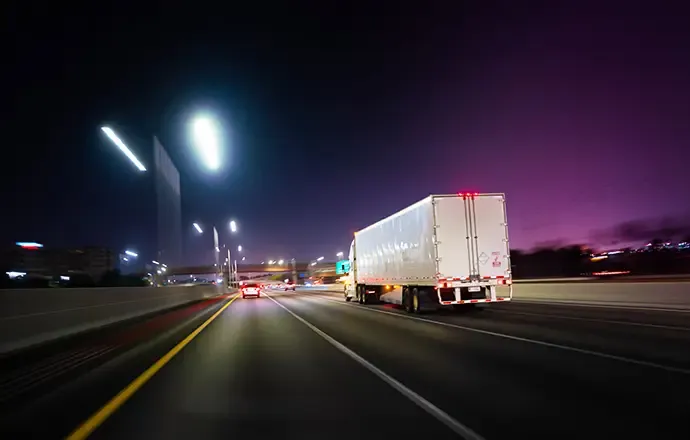Prioritizing Supply Chain Safety
Safety-oriented cultures come from shippers and carriers who value route consistency for drivers.
Why Supply Chain Safety Matters
Cultures with supply chain safety set as a priority protect drivers, employees, the public, and freight while delivering extensive benefits. Working with an experienced dedicated logistics provider to develop a safety-first strategy offers many benefits to your bottom line, including enhancing your brand reputation, mitigating legal and financial risks, reducing driver turnover costs, and managing rising insurance premiums.
Want to learn how to build a safety-first approach into your logistics operations? Download the Safety Guide and White Paper for actionable insights and proven strategies.

Why You Should Partner With A Dedicated Logistics Provider
Financial Impact

Human Impact

Operational Impact
Make Supply Chain Safety Your Next Priority
Test Your Trucking Safety Knowledge: Are You Road Ready?
#1. In 2021, approximately how many fatal accidents involved large trucks or buses?
According to the FMCSA, there were 5,340 fatal crashes involving large trucks and buses across the United States in 2021. A majority of those fatal crashes, 5,149, involved large trucks which are defined as a vehicle with a gross vehicle weight rating (GVWR) or gross combination weight rating (GCWR) greater than 10,000 pounds.
Data Sources: National Highway Traffic Safety Administration (NHTSA), Fatality Analysis Reporting System (FARS).
#2. Of the approximately 3.1 trillion vehicle miles traveled by all vehicles in the United States in 2021, what percentage of those were traveled by large trucks (defined as a vehicle with a gross vehicle weight rating (GVWR) or gross combination weight rating (GCWR) greater than 10,000 pounds)?
In 2021, large trucks accounted for 10.4% of the 3.1 trillion vehicle miles traveled in the United States—equivalent to 327 billion miles. With 494,000 large trucks involved in injury crashes that year, this translates to one injury crash for every 662,000 miles traveled by large trucks.
Data Sources: FMCSA, Motor Carrier Management Information System (MCMIS), data snapshot as of December 30, 2022.
#3. How many large trucks (defined as a vehicle with a gross vehicle weight rating (GVWR) or gross combination weight rating (GCWR) greater than 10,000 pounds) were registered in the United States in 2021?
13,859,181 large trucks were registered in the United States in 2021. Of the 327 billion vehicle miles travelled by large trucks in 2021, each truck drove an average distance of 23,594 miles.
Data Source: Federal Highway Administration (FHWA), Highway Statistics 2021, Table VM-1
Data Sources: FMCSA, Motor Carrier Management Information System (MCMIS), data snapshot as of December 30, 2022.
#4. This number of single-unit and combination large trucks (large trucks defined as a vehicle with a gross vehicle weight rating (GVWR) or gross combination weight rating (GCWR) greater than 10,000 pounds) accrued at least 1 million vehicle miles travelled in the United States in 2021.
Over 327,000 single-unit and combination large trucks travelled at least 1 million vehicle miles in 2021. That means over 327,000 vehicles met the vehicle mile travelled distance of 662,000 miles—which is the average number vehicle miles travelled by large trucks involved in an injury-related crash.
Data Source: Federal Highway Administration (FHWA), Highway Statistics 2021, Table VM-1.
#5. How many tons of freight were shipped by trucks in the United States in 2021?
Just over 11.7 billion tons of freight were moved by truck in 2021. This compares to rail at just over 1 billion tons of freight shipped.
Data Source: U.S. Department of Transportation, Bureau of Transportation Statistics and Federal Highway Administration, Freight Analysis Framework, version 5.3, 2022, https://www.bts.gov/faf.
#6. What number of inspections were conducted by Federal and State inspectors in the United States in 2022?
2,984,331 inspections were conducted by Federal and State inspectors in 2022. An inspection is an examination of an individual commercial motor vehicle (CMV) and/or driver by an authorized safety inspector. State inspectors conduct approximately 95 percent of inspections, with the remainder conducted by Federal inspectors. The inspection determines whether the driver and/ or the CMV is in compliance with the Federal Motor Carrier Safety Regulations (FMCSRs) or the Hazardous Materials Regulations (HMRs), as appropriate. Serious violations result in the issuance of vehicle or driver out-of-service (OOS) orders. These violations must be corrected before the affected driver or vehicle can return to service.
Data Source: FMCSA, Motor Carrier Management Information System (MCMIS), data snapshot as of January 27, 2023.
#7. Approximately how many OOS (out-of-service) orders were issued in 2022 during random/routine vehicle inspections?
Over 2 million vehicle inspections resulted in 455,079 OOS violations issued in 2022.
Data Source: FMCSA, Motor Carrier Management Information System (MCMIS), data snapshot as of January 27, 2023.
#8. How many non-fatal crashes involved at least one truck or bus in the United States in 2021?
In 2021, of the 39,508 fatal crashes on the Nation’s roadways, 5,340 (13.5 percent) involved at least one large truck or bus. In addition, there were an estimated 6,064,000 nonfatal crashes, 531,000 (8.7 percent) of which involved at least one large truck or bus. For more information on large truck and bus crashes, please refer to the annual Large Truck and Bus Crash Facts publication available at https://www.fmcsa.dot.gov/safety/data-and-statistics/large-truck-andbus-crash-facts.
Data Sources: National Highway Traffic Safety Administration (NHTSA) and Fatality Analysis Reporting System (FARS).
#9. What is the estimated cost of large truck and bus crashes that occurred in the United States in 2021?
It is estimated that the cost of large truck and bus crashes is $73 billion for fatal crashes, $37 billion for injury crashes, and $18 billion for property damage only crashes.
Data Sources: Crash Costs for Highway Safety Analysis, Federal Highway Administration (FHWA); The Economic and Societal Impact of Motor Vehicle Crashes, 2019 (Revised), National Highway Traffic Safety Administration (NHTSA); and Delay and Environmental Costs of Truck Crashes, Volpe Center, adjusted to current dollars, and a year 2021 value of a statistical life (VSL); NHTSA, FARS, and CRSS.
#10. What is the average cost of a commercial truck accident?
As an average figure, a commercial truck accident that includes an injured person could have an average cost of $148,279. If the truck accident involves a fatality, then this cost can increase significantly to over $7 million.
On average, a commercial truck accident resulting in an injury could cost you $148,000. If the truck accident involves a fatality, that cost would increase significantly, costing carriers over $7 million.
Learn how a safety-oriented transportation provider could help.
Source: https://missionfinancialservices.net/average-cost-of-a-commercial-truck-accident/
#11. According to the FMCSA, what is the comprehensive cost* of a large truck accident involving a fatality?
According to the FMSCA, the comprehensive cost of a large truck accident involving a fatality is $14,578,771.
*Comprehensive costs include economic costs and costs associated with Quality Adjusted Life Years (QALY). Economic costs include lost productivity; medical costs; legal and court costs; emergency service costs; insurance administration costs; congestion costs; property damage; and workplace losses.
#12. According to the FMCSA, what is the comprehensive cost* of a large truck accident involving an injury?
According to the FMSCA, the comprehensive cost of a large truck accident involving an injury is $383,168.
*Comprehensive costs include economic costs and costs associated with Quality Adjusted Life Years (QALY). Economic costs include lost productivity; medical costs; legal and court costs; emergency service costs; insurance administration costs; congestion costs; property damage; and workplace losses.
Key Safety Benefits: Building a Safety-First Supply Chain

Safety-Oriented Culture and Operations
- Train your fleets and internal teams to prioritize safety across all processes.
- Build/embrace accountability with clear safety metrics and reporting.
- Companies with a strong safety culture see up to 70% fewer workplace incidents. – Source, ThomasNet

Fleet Technology & Preventive Maintenance

Compliance & Risk Management
Make Supply Chain Safety Your Competitive Advantage
Cost
Private Fleet
High initial capital investment, ongoing maintenance, and operational costs.
Dedicated Transportation Provider
Predictable monthly costs, no large upfront investment.
Control
Private Fleet
Requires in-house expertise for management and compliance.
Dedicated Transportation Provider
Provider handles operations, allowing focus on core business.
Scalability
Private Fleet
Scaling requires significant time, capital, and resources.
Dedicated Transportation Provider
Easy to scale up or down based on demand.
Maintenance & Compliance
Private Fleet
Responsible for vehicle upkeep, regulatory compliance, and driver management.
Dedicated Transportation Provider
Provider handles maintenance, compliance, and driver management.
Reliability
Private Fleet
Reliability depends on internal management efficiency.
Dedicated Transportation Provider
Established providers often have robust systems for reliability.
Flexibility
Private Fleet
Limited by fleet size and internal processes.
Dedicated Transportation Provider
Flexibility in contract terms and capacity adjustments.
Branding & Customer Experience
Private Fleet
Higher effort needed to manage and deliver consistently.
Dedicated Transportation Provider
Can focus on core services while the provider manages logistics. Drivers typically are familiar with customers and routes which reduces risk and increases customer satisfaction.
Risk
Private Fleet
High risk in terms of liability, accidents, and regulatory compliance.
Dedicated Transportation Provider
Reduced liability and operational risk.
Stats Counter
Commercial Truck Inspections in the United States
7.61 Inspections Per Minute
Injury Accidents Involving Large Trucks
0.94 Accidents Per Minute
Out of Service Orders Issued
0.87 OOS Orders Per Minute
Non-Fatal Crashes involving at least on truck or bus in the United States
1.01 Non-fatal Crashes Per Minute
Cost of large truck and bus accidents in United States
$226,407.91 Dollars Per Minute







